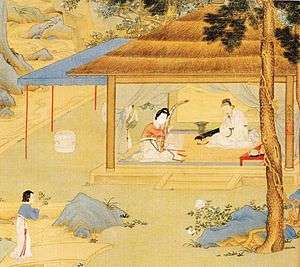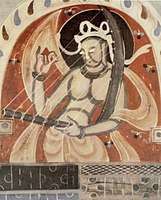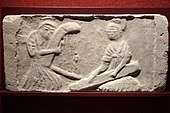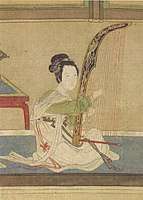Konghou
The konghou or hunghau (Chinese: 箜篌; Chinese: 空侯; pinyin: kōnghóu; Jyutping: Hung1Hau4) is an ancient Chinese harp. The instrument became extinct sometime in the Ming Dynasty. It has been revived in the 20th century as a double bridge harp; the modern version of the instrument does not resemble the ancient one, but its shape is similar to Western concert harps.
| Classification | |
|---|---|
| Related instruments | |
History

The wo-konghou, or horizontal konghou, was first mentioned in written texts in the Spring and Autumn period (770–476 BC). The su-konghou, or vertical konghou first appeared in the Eastern Han Dynasty (25–220AD). The phoenix-headed konghou was introduced from India in the Eastern Jin Dynasty (317-420 AD). The konghou was used to play yayue (court music) in the Kingdom of Chu. During the Han Dynasty (206 BC–220 AD) the konghou was used in qingshangyue (a music genre). Beginning in the Sui Dynasty (581-618), the konghou was also used in yanyue (banquet music). Konghou playing was most prevalent in the Sui and Tang dynasties. It was generally played in rites and ceremonies and gradually prevailed among the ordinary people.
The konghou in other places
The instrument was adopted in the ancient times in Korea, where it was called gonghu (hangul: 공후; hanja: 箜篌), but it is no longer used there. There were three subtypes according to shape:
- Sogonghu (hangul: 소공후; hanja: 小箜篌; literally "small harp")photo
- Sugonghu (hangul: 수공후; hanja: 豎箜篌; literally "vertical harp")photo
- Wagonghu (hangul: 와공후; hanja: 臥箜篌; literally "lying down harp")[1]
Similarly, the kudaragoto (百済琴 / くだらごと), also called kugo (箜篌 / くご) of Japan was in use in some Togaku (Tang music) performances during the Nara period, but seems to have died out by the 10th century. It has recently been revived in Japan, and the Japanese composer Mamoru Fujieda has composed for it.[2]
Tomoko Sugawara commissioned a playable kugo harp from builder Bill Campbell and earned an Independent Music Awards nomination for her 2010 album, Along the Silk Road, playing traditional and newly written works for the instrument.
Modern konghou
The konghou was "revived" in the 20th century and this instrument resembles a Western concert harp. The main feature that distinguishes the contemporary konghou from the Western harp is that the modern konghou's strings are folded over to make two rows, which enables players to use advanced playing techniques such as vibrato and bending tones. Paired strings on opposite sides of the instrument are tuned to the same note. They start from a tuning peg and beyond the playing area travel over two bridges on opposite sides of the instrument, and are then fixed at the far end to opposite sides of a freely moving lever so that depressing one of the string pairs raises the pitch of the other. The two rows of strings also make it suitable for playing swift rhythms and overtones.
Gallery
 Konghou, Northern Wei Dynasty 386–535
Konghou, Northern Wei Dynasty 386–535.jpg) Konghou, tomb of Wei Guizhen (AD 597-665)
Konghou, tomb of Wei Guizhen (AD 597-665) Konghou (left) and guqin, Tang dynasty (618-907), unearthed in Jiuquan City. Museum of Gansu Province.
Konghou (left) and guqin, Tang dynasty (618-907), unearthed in Jiuquan City. Museum of Gansu Province. Konghou from silk painting by Qiu Ying (1494-1552), "Spring Morning in the Han Palace"
Konghou from silk painting by Qiu Ying (1494-1552), "Spring Morning in the Han Palace" Modern Konghou playing on stage
Modern Konghou playing on stage
References
- photo Archived September 28, 2007, at the Wayback Machine date=November 2014
- Archived May 18, 2007, at the Wayback Machine